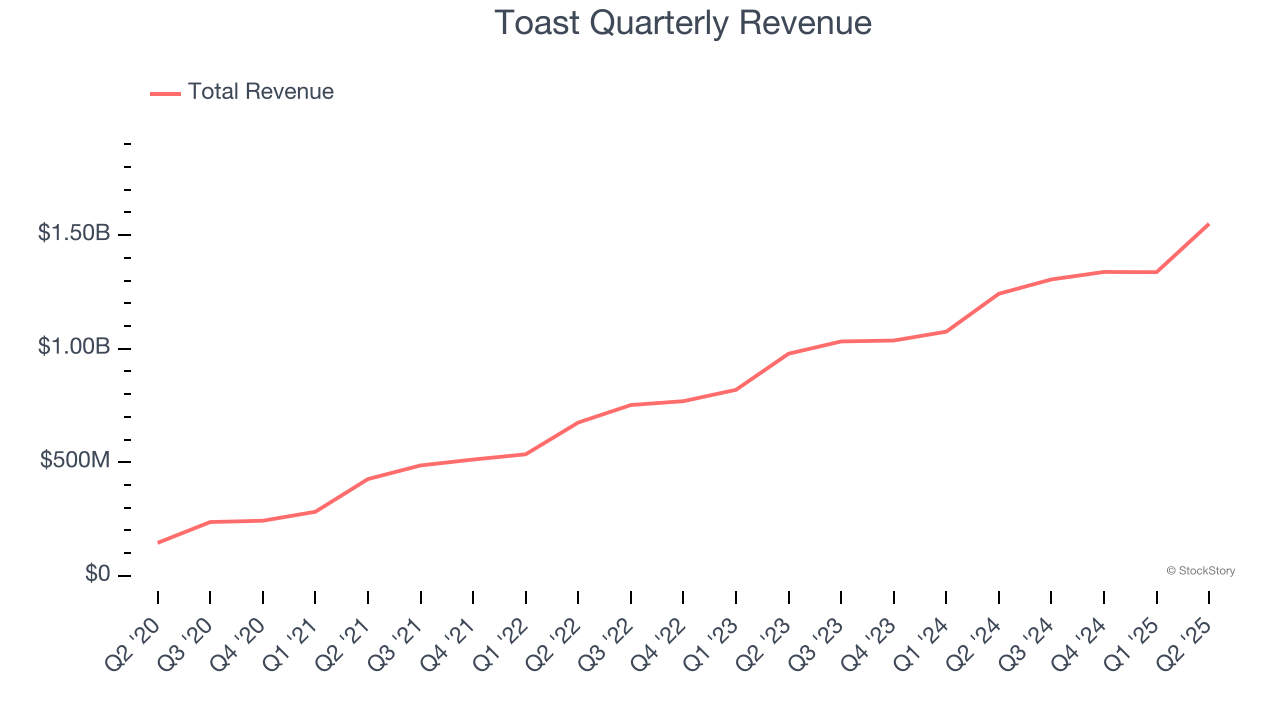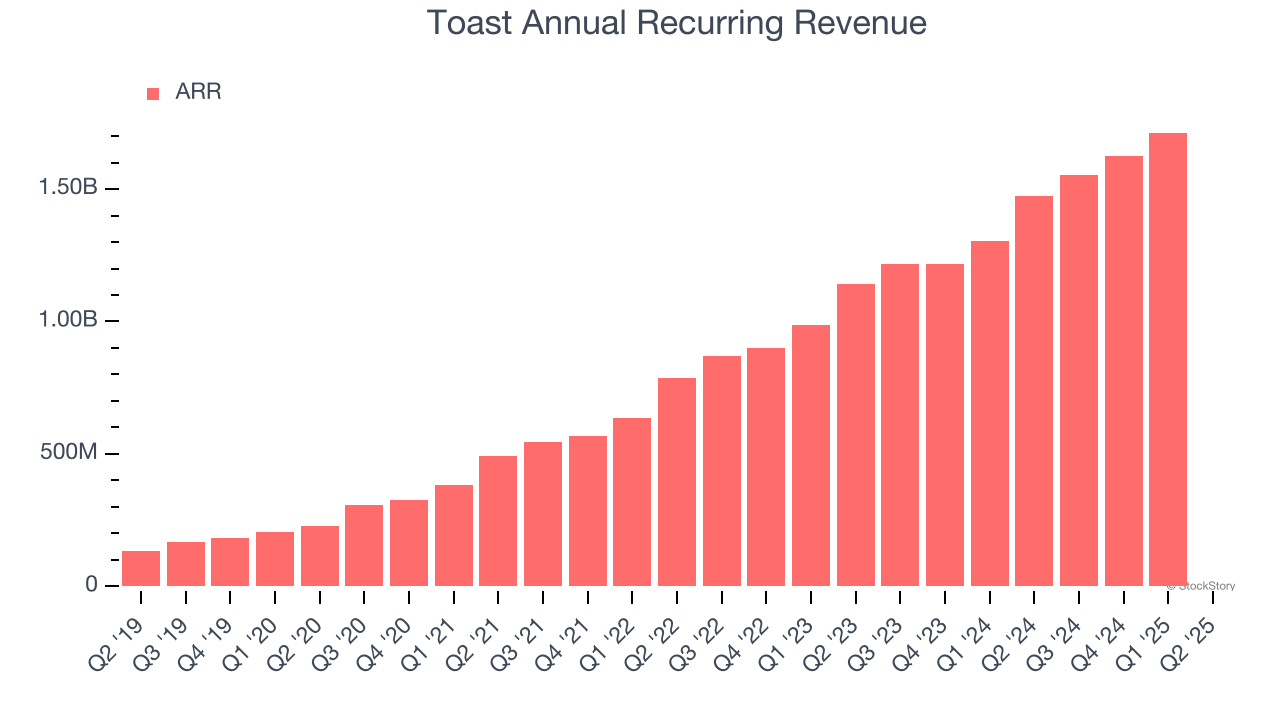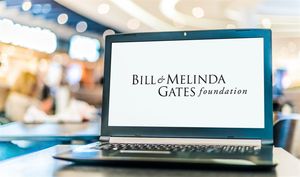
Restaurant software platform Toast (NYSE: TOST) announced better-than-expected revenue in Q2 CY2025, with sales up 24.8% year on year to $1.55 billion. Its GAAP profit of $0.13 per share was 22.8% above analysts’ consensus estimates.
Is now the time to buy Toast? Find out by accessing our full research report, it’s free.
Toast (TOST) Q2 CY2025 Highlights:
- Revenue: $1.55 billion vs analyst estimates of $1.52 billion (24.8% year-on-year growth, 2.1% beat)
- EPS (GAAP): $0.13 vs analyst estimates of $0.11 (22.8% beat)
- Adjusted EBITDA: $161 million vs analyst estimates of $140.6 million (10.4% margin, 14.5% beat)
- EBITDA guidance for the full year is $575 million at the midpoint, above analyst estimates of $567.5 million
- Operating Margin: 5.2%, up from 0.4% in the same quarter last year
- Free Cash Flow Margin: 13.4%, up from 5.2% in the previous quarter
- Annual Recurring Revenue: $1.9 million at quarter end, down 99.9% year on year
- Market Capitalization: $28.49 billion
“I’m proud of the team for delivering another strong quarter - we added a record 8,500 net new locations, recurring gross profit1 grew 35% year over year, and Adjusted EBITDA scaled to $161 million. Both our core U.S. restaurant business and our new market segments performed very well, with enterprise, international, and food and beverage retail passing 10,000 live locations. We are thrilled to welcome another 1,300+ unit chain to Toast as we continue to move upmarket and our international team has launched our first customer in Australia. We are also excited to announce the release of Toast Go® 3, our most powerful handheld yet, as well as a partnership with American Express aimed at delivering personalized experiences and expanding guest reach to help our customers provide better hospitality and grow. We’re building a platform to help local businesses thrive and I’ve never been more confident in our ability to deliver on that ambition and lead this industry,” said Aman Narang, Toast CEO and Co-Founder.
Company Overview
Founded by three MIT engineers at a local Cambridge bar, Toast (NYSE: TOST) provides integrated point-of-sale (POS) hardware, software, and payments solutions for restaurants.
Revenue Growth
Reviewing a company’s long-term sales performance reveals insights into its quality. Any business can put up a good quarter or two, but many enduring ones grow for years. Thankfully, Toast’s 35.8% annualized revenue growth over the last three years was excellent. Its growth beat the average software company and shows its offerings resonate with customers, a helpful starting point for our analysis.

This quarter, Toast reported robust year-on-year revenue growth of 24.8%, and its $1.55 billion of revenue topped Wall Street estimates by 2.1%.
Looking ahead, sell-side analysts expect revenue to grow 19.8% over the next 12 months, a deceleration versus the last three years. Despite the slowdown, this projection is admirable and suggests the market sees success for its products and services.
Today’s young investors won’t have read the timeless lessons in Gorilla Game: Picking Winners In High Technology because it was written more than 20 years ago when Microsoft and Apple were first establishing their supremacy. But if we apply the same principles, then enterprise software stocks leveraging their own generative AI capabilities may well be the Gorillas of the future. So, in that spirit, we are excited to present our Special Free Report on a profitable, fast-growing enterprise software stock that is already riding the automation wave and looking to catch the generative AI next.
Annual Recurring Revenue
While reported revenue for a software company can include low-margin items like implementation fees, annual recurring revenue (ARR) is a sum of the next 12 months of contracted revenue purely from software subscriptions, or the high-margin, predictable revenue streams that make SaaS businesses so valuable.
Toast’s ARR came in at $1.9 million in Q2, and it averaged 1.9% year-on-year declines over the last four quarters. This alternate topline metric underperformed its total sales, which likely means that the recurring portions of the business are growing slower than less predictable, choppier ones such as implementation fees. If this continues, the quality of its revenue base could decline. 
Customer Acquisition Efficiency
The customer acquisition cost (CAC) payback period measures the months a company needs to recoup the money spent on acquiring a new customer. This metric helps assess how quickly a business can break even on its sales and marketing investments.
Toast’s recent customer acquisition efforts haven’t yielded returns as its CAC payback period was negative this quarter, meaning its incremental sales and marketing investments outpaced its revenue. The company’s inefficiency indicates it operates in a highly competitive environment where there is little differentiation between Toast’s products and its peers.
Key Takeaways from Toast’s Q2 Results
We were impressed by how significantly Toast blew past analysts’ EBITDA expectations this quarter. We were also glad its full-year EBITDA guidance slightly exceeded Wall Street’s estimates. On the other hand, its annual recurring revenue missed and its EBITDA guidance for next quarter was in line with Wall Street’s estimates. Overall, this print was mixed. Investors were likely hoping for more, and shares traded down 1.6% to $46.97 immediately after reporting.
So do we think Toast is an attractive buy at the current price? The latest quarter does matter, but not nearly as much as longer-term fundamentals and valuation, when deciding if the stock is a buy. We cover that in our actionable full research report which you can read here, it’s free.




